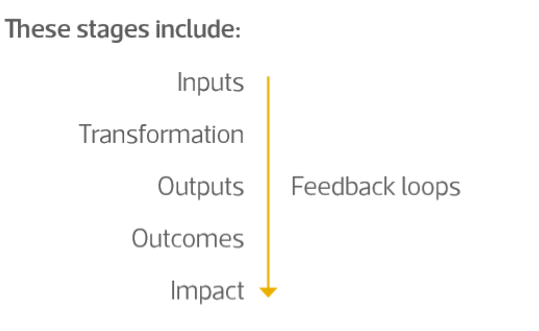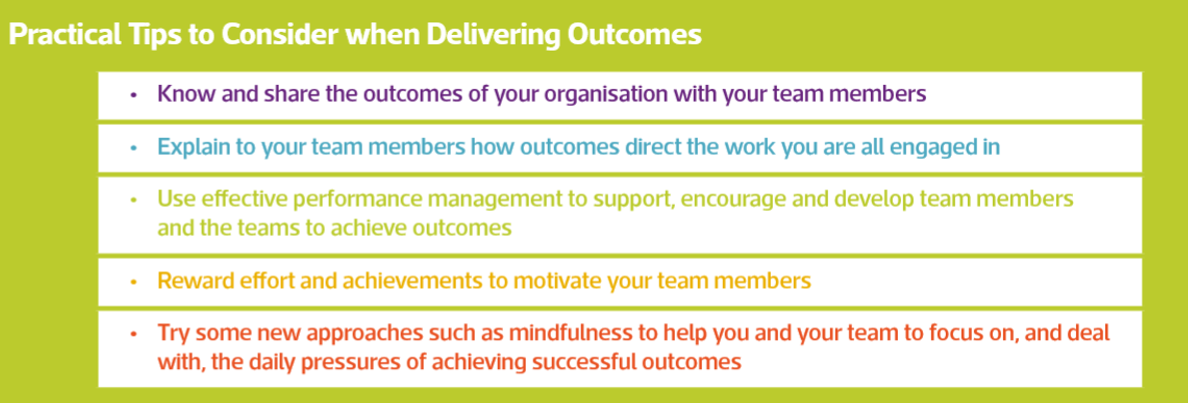

Outputs not inputs
All organisations exist to transform inputs (such as a skilled workforce, materials, information, capital equipment, land, buildings) into outputs (such as goods and services) to provide value for users. To achieve the best possible outcome, the final end result for users, your organisation must focus on maximizing the quality of its transformation processes. Delivery of outcomes drives your organisation’s growth, profitability and sustainable impact.
Measurement
Once your leadership team has decided the direction of the organisation and what outcomes and impact the organisation wants to achieve, they need to decide how to measure the performance of transforming inputs into outputs. To do this, they establish benchmarks or measures against which to measure work performance, quality and output. These are known as Key Performance Indicators (KPIs). They are measures that show the extent to which you are achieving your required outcomes and are used to evaluate your success at reaching targets. Your choice of KPIs depends on your type of organisation and which part of it you are looking to track. Organisations use KPIs at various levels to evaluate how well they are doing. Each department will use different KPI types to measure success based on its specific targets.
KPIs should be:
- related to results, or outputs rather than efforts,
- within job holder’s control,
- objective and observable,
- such that data is available for measurement,
- used or adapted from existing measures wherever possible.
They may be stated as:

Some of your KPIs may focus on processes in departments such as manufacturing, sales, administration, dispatch or a call centre, while other KPIs focus on the overall performance of your organisation. In not-for-profit organisations, overall performance is usually measured using an indicator of value for money; examples include social media engagement, in-patient flow, revenue cycle, administrative, programme or fundraising efficiency (such as donor growth, donation growth, donor retention rate, fundraising return on investment). Consistently making profit is the major overall performance indicator of every company, large or small.
Profit
There are three levels of profit:
- Gross profit is total sales minus the cost of goods sold
- Operating profit is gross profit minus operating expenses (such as salaries, administrative expenses)
- Net profit is operating profit minus all expenses (including taxes and interest)
Each level gives information about the business’s performance, and is often compared over various time periods, or with other businesses.
Another way of using profit information is to calculate a company’s return on investment.
Return on Investment (ROI)
Whereas profit reflects the performance of a business, return on investment focuses on the money you invest in the business and the return you achieve on that money, based on the net profit of the business. ROI is the most common profitability ratio. You can use it to evaluate the efficiency of an investment in a company by dividing its
net profit (return) by the resources committed (investment):
ROI = Net Profit / Cost of Investment
For example, a small start-up business makes £53,500 gross profit in the first year with a total investment of £40,000. What was the ROI?
(£53,500-£40,000)/ £40,000 = 0.34x 100 =34%
(£53,500-£40,000)/ £40,000 = 0.34x 100 =34%
You can use ROI in various ways, for example to gauge your pricing policy, to assess a proposed investment in capital equipment, or to evaluate your inventory costs.
Knowing your key performance indicators can really help you to focus your mind on what needs to be done to achieve outcomes. Running a successful department demands your attention. However, leaders are faced with a constantly changing organisation environment, continual interruptions, distractions and stresses at a time when they really need to focus and make thoughtful decisions. To be an effective leader, you need to choose consciously where to focus your attention – to do this you need to be constantly mindful.

Mindfulness
Leaders are under ever-increasing pressure to manage inputs and deliver outcomes to meet KPIs and targets in complex and often contradictory environments. ‘Mindfulness’ is being adopted by an increasing number of organisations to reduce stress levels and to increase personal and organisational productivity. Mindfulness is a mental state that is achieved by focusing your awareness on the present moment. It is a technique that can be used to help you to be fully aware of where you are and what you are doing. It enables you to block out other priorities to allow you to focus on what is happening in the present moment. By focusing on the present and not allowing your mind to drift to the past or wander to the future, you increase the chances of making the best possible choices in a given situation.
To be mindful, you have to adopt a particular approach to your work. You need to focus your attention on what is happening with a particular intention, putting aside any judgements and certainty and allow your mind to:
- be curious about what you are attending to in order to discover something new,
- be open to the situation, including negative or unpleasant aspects that you would rather not attend to,
- be flexible and open to change.
Research is underway to examine the benefits of this and other techniques that might help leaders to work within highly complex environments, and sustain good levels of well being.
How well do you deliver outcomes? Test yourself with our Scorecard.
If you’re a member, you can test yourself on Delivering Outcomes and see if you meet the standard.
Spotlights
Further Resources
From the blog













